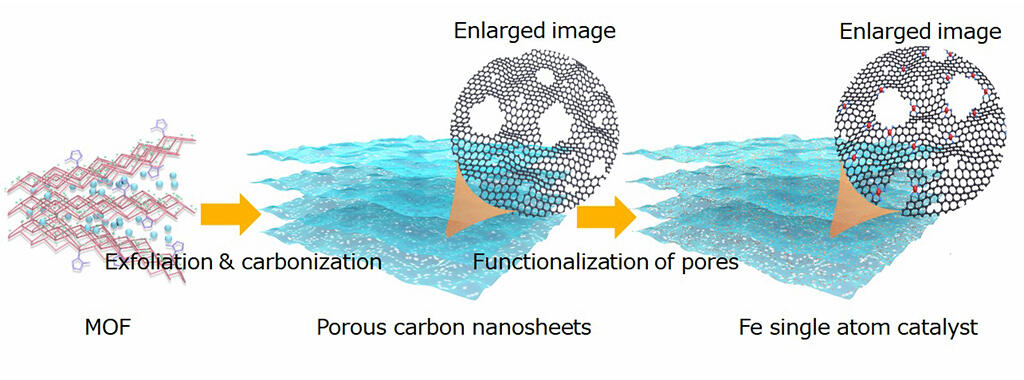An international joint research team led by the National Institute for Materials Science (NIMS) and Waseda University has successfully synthesized a new porous carbon nanosheet by developing a method to create a nearly infinite number of pores, which have been difficult to drill to date.

Provided by NIMS
When typical non-porous 2D nanosheets are stacked on top of each other, they eventually lose much of their specific surface area, reducing their potential for many electrochemical applications. In this study, the research team focused on the fact that a material called a metal-organic framework (MOF) can be exfoliated into nanosheets and succeeded in synthesizing a new material by carbonizing the MOF-derived nanosheets after exfoliation. The MOF sheet developed by the research team has many pores, enabling it to retain many catalytically active sites even when converted to electrodes (even when re-stacked).
The sheet is an ultrathin two-dimensional sheet with a thickness of 1.5 nm, and its surface is covered with numerous pores, which penetrate through the sheet. The pore size in the two-dimensional porous carbon sheet has a distribution from the micro-pore region to meso-pore domain of about 5 nm, which can be adjusted to some extent by changing the exfoliation and carbonization conditions of the MOF. With its two-dimensional morphology, high porosity, and other features not found in other two-dimensional nanosheets and spatial materials, the sheet is expected to play an active role in a wide range of electrochemical applications, including energy conversion and storage.
"To further improve the catalytic activity, we would like to move forward with using materials informatics to extract the critical factors and optimum values that are responsible for performance, and based on the results, adjust things like the nitrogen content, surface area and pore size to develop single-site catalysts using other metal elements," says Yusuke Yamauchi of NIMS and leader of the research group.
■ Metal Organic Framework (MOF) A generic term for porous materials in which lattice metals and organic ligands form a network by coordinative bonding to each other. They have a surface area that far exceeds that of activated carbon and zeolites.
Journal Information
Publication: Journal of the American Chemical Society
Title: Metal-Organic Framework-Derived Graphene Mesh: a Robust Scaffold for Highly Exposed Fe-N4 Active Sites toward an Excellent Oxygen Reduction Catalyst in Acid Media
DOI: 10.1021/jacs.2c00719
This article has been translated by JST with permission from The Science News Ltd.(https://sci-news.co.jp/). Unauthorized reproduction of the article and photographs is prohibited.




